Abstract
The presence of genes encoding pyrogenic exotoxins type A (speA), B (speB), and C (speC) and streptolysin O (slo) was determined by the polymerase chain reaction (PCR) to target specific sequences in 152 strains of group A streptococci. These included reference strains, representative M and T type strains, and strains associated with scarlet fever and pharyngitis collected between 1940 to 1991 and included strains from patients with severe invasive streptococcal infections. PCR amplicons were detected by agarose gel electrophoresis, and specificity was established by restriction fragment analysis. The frequency of occurrence for each target gene among all strains tested was 33.6% for speA, 99.3% for speB, 28.9% for speC, and 100% for slo. Strains of non-group A streptococci, recognized toxigenic bacterial pathogens, and pneumolysin-producing Streptococcus pneumoniae strains were negative for all targeted gene sequences. Detection limits in the PCR were found to be 100 pg of total nucleic acids for the speB and speC genes and 1 ng for the speA and slo genes. Isolates associated with scarlet fever, pharyngitis, and severe invasive infections showed statistically significant differences in the presence of speA, with scarlet fever strains having the highest association (81.3%), severe infections the next highest association (42.9%), and pharyngitis the lowest association (18.4%). Although no significant differences were observed in speC frequencies in isolated associated with the three disease categories, a genotype of speB slo was significantly higher in isolates associated with pharyngitis (54.1%) than in strains associated with scarlet fever (18.8%) or severe invasive disease (23.8%). Streptolysin O targets were present in all the isolates tested, and only a single strain (T-11-M-11) was devoid of targeted speB sequences, thereby demonstrating that neither speB nor slo is associated with any particular clinical presentation.
Full text
PDF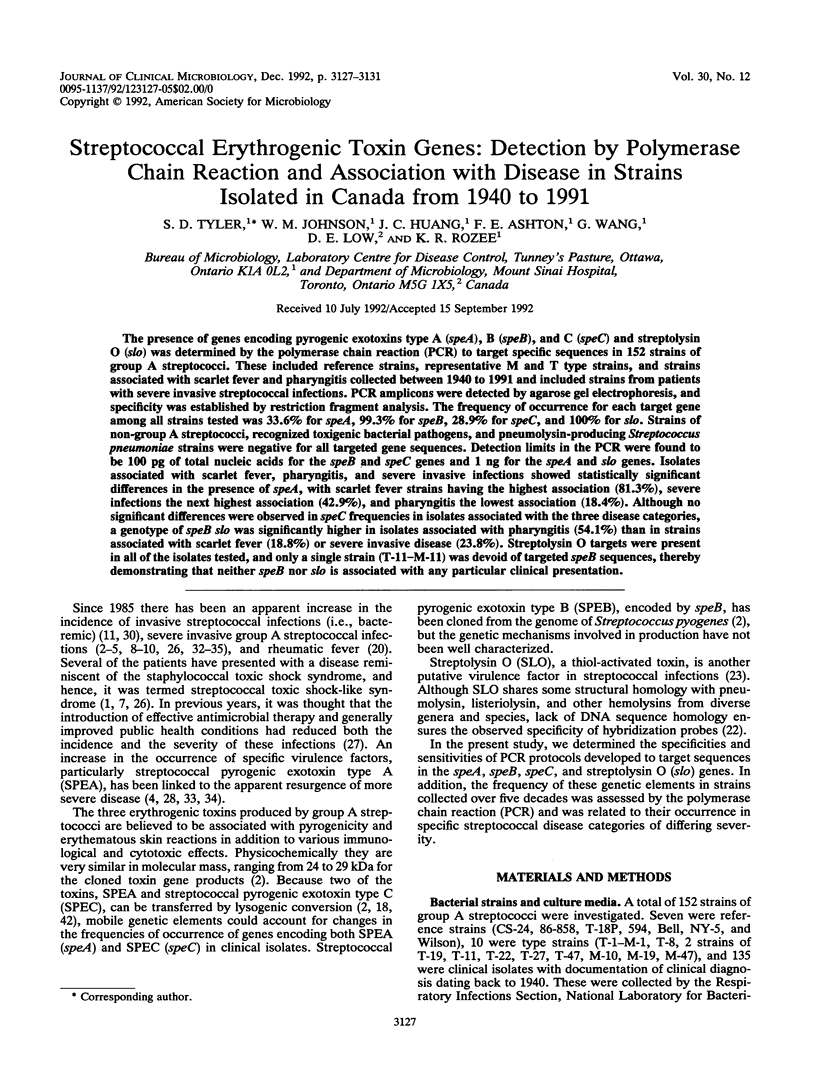
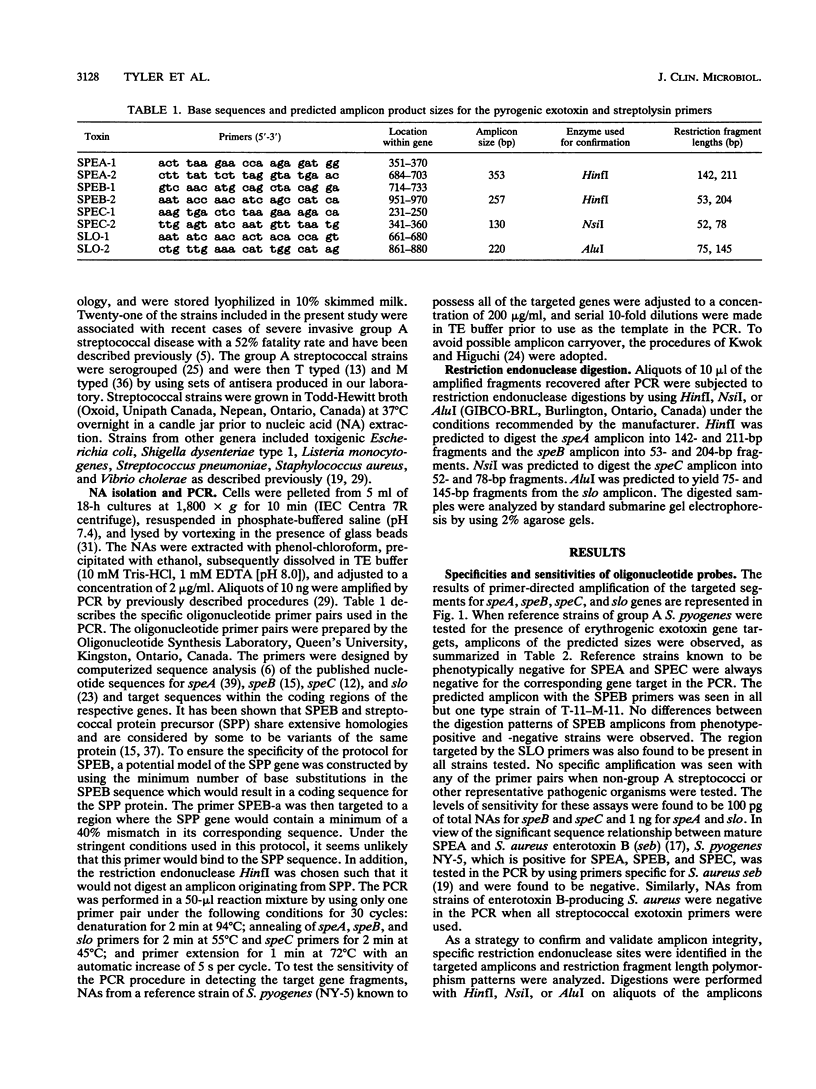
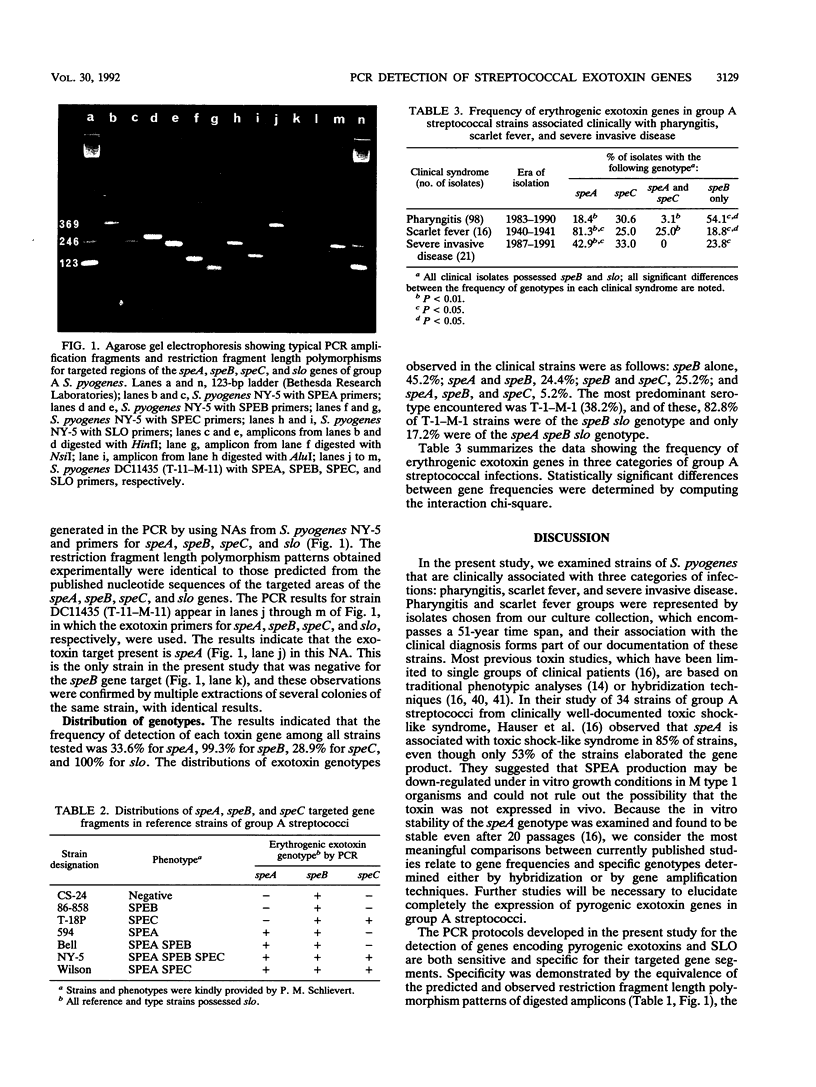
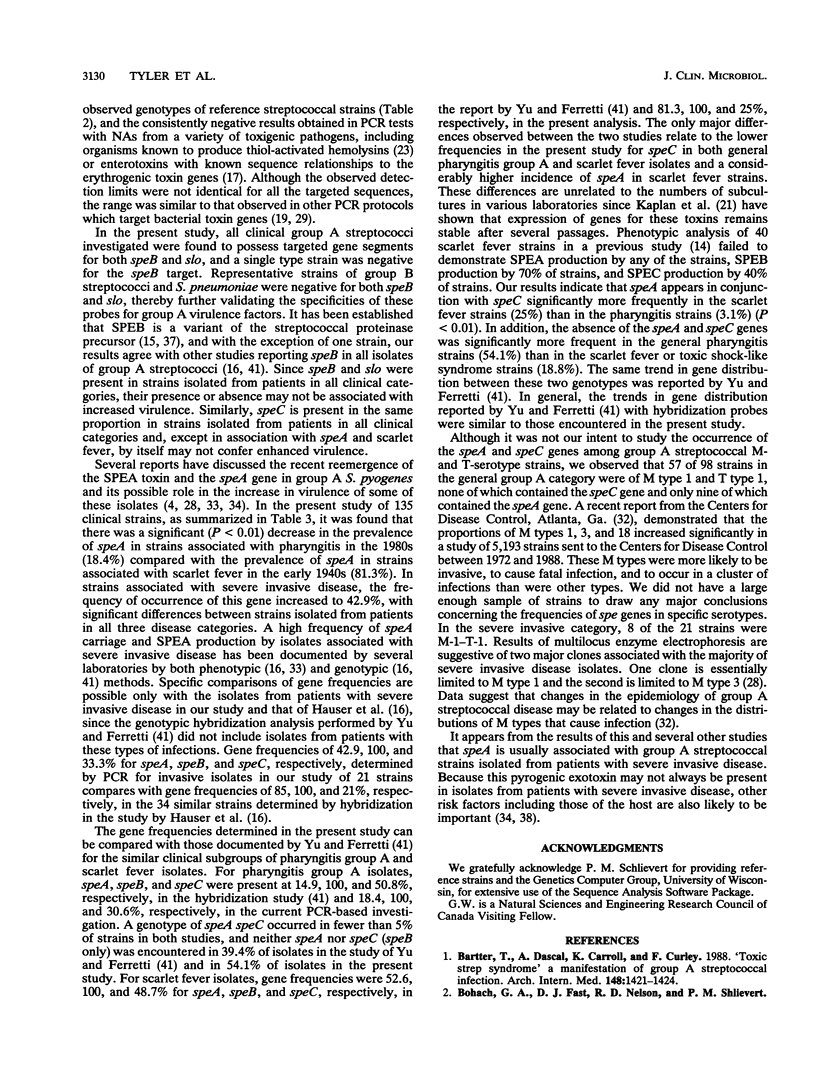
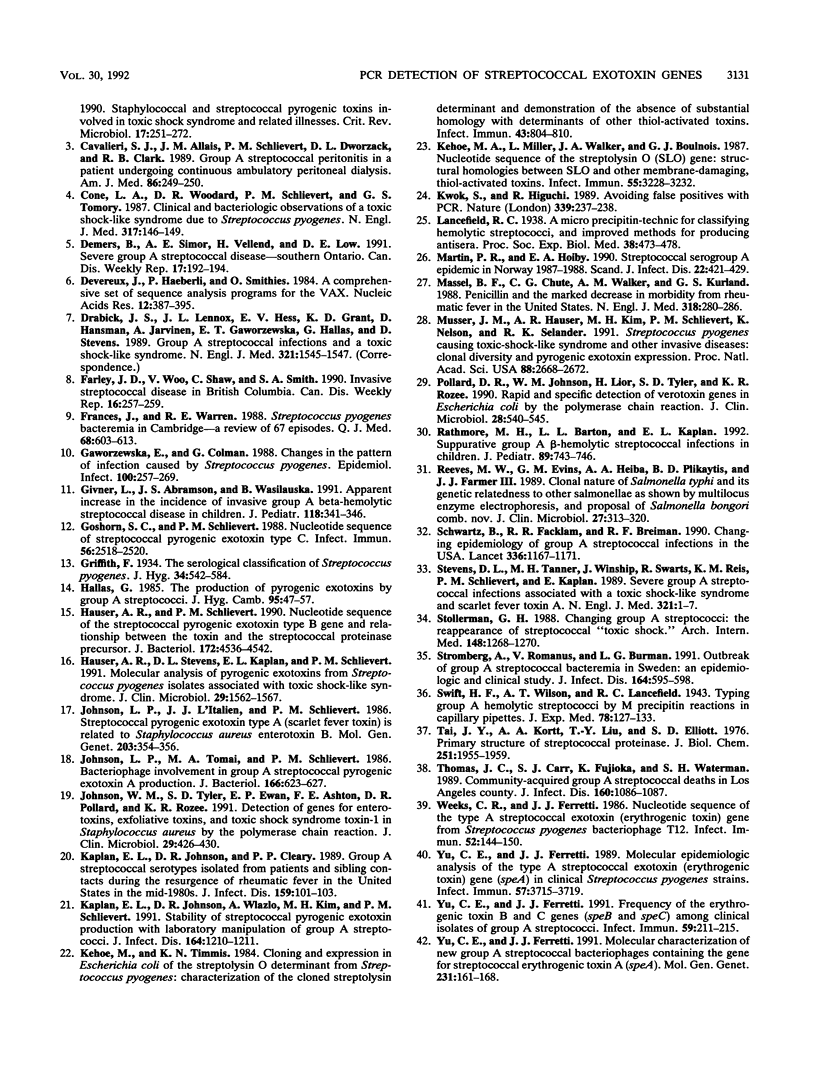
Images in this article
Selected References
These references are in PubMed. This may not be the complete list of references from this article.
- Bartter T., Dascal A., Carroll K., Curley F. J. 'Toxic strep syndrome'. A manifestation of group A streptococcal infection. Arch Intern Med. 1988 Jun;148(6):1421–1424. doi: 10.1001/archinte.148.6.1421. [DOI] [PubMed] [Google Scholar]
- Cavalieri S. J., Allais J. M., Schlievert P. M., Dworzack D. L., Clark R. B. Group A streptococcal peritonitis in a patient undergoing continuous ambulatory peritoneal dialysis. Am J Med. 1989 Feb;86(2):249–250. doi: 10.1016/0002-9343(89)90282-9. [DOI] [PubMed] [Google Scholar]
- Cone L. A., Woodard D. R., Schlievert P. M., Tomory G. S. Clinical and bacteriologic observations of a toxic shock-like syndrome due to Streptococcus pyogenes. N Engl J Med. 1987 Jul 16;317(3):146–149. doi: 10.1056/NEJM198707163170305. [DOI] [PubMed] [Google Scholar]
- Demers B., Low D. E., Simor A. E., Vellend H., Jamieson F., Walmsley S., Green K., Krishnan C. Severe group A streptococcal disease--southern Ontario. Ontario Streptococcal Study Group. Can Dis Wkly Rep. 1991 Aug 31;17(35):192–194. [PubMed] [Google Scholar]
- Devereux J., Haeberli P., Smithies O. A comprehensive set of sequence analysis programs for the VAX. Nucleic Acids Res. 1984 Jan 11;12(1 Pt 1):387–395. doi: 10.1093/nar/12.1part1.387. [DOI] [PMC free article] [PubMed] [Google Scholar]
- Farley J. D., Woo V., Shaw C., Smith J. A. Invasive streptococcal disease in British Columbia. Can Dis Wkly Rep. 1990 Dec 22;16(51):257–259. [PubMed] [Google Scholar]
- Francis J., Warren R. E. Streptococcus pyogenes bacteraemia in Cambridge--a review of 67 episodes. Q J Med. 1988 Aug;68(256):603–613. [PubMed] [Google Scholar]
- Gaworzewska E., Colman G. Changes in the pattern of infection caused by Streptococcus pyogenes. Epidemiol Infect. 1988 Apr;100(2):257–269. doi: 10.1017/s095026880006739x. [DOI] [PMC free article] [PubMed] [Google Scholar]
- Givner L. B., Abramson J. S., Wasilauskas B. Apparent increase in the incidence of invasive group A beta-hemolytic streptococcal disease in children. J Pediatr. 1991 Mar;118(3):341–346. doi: 10.1016/s0022-3476(05)82144-4. [DOI] [PubMed] [Google Scholar]
- Goshorn S. C., Schlievert P. M. Nucleotide sequence of streptococcal pyrogenic exotoxin type C. Infect Immun. 1988 Sep;56(9):2518–2520. doi: 10.1128/iai.56.9.2518-2520.1988. [DOI] [PMC free article] [PubMed] [Google Scholar]
- Hallas G. The production of pyrogenic exotoxins by group A streptococci. J Hyg (Lond) 1985 Aug;95(1):47–57. doi: 10.1017/s0022172400062276. [DOI] [PMC free article] [PubMed] [Google Scholar]
- Hauser A. R., Schlievert P. M. Nucleotide sequence of the streptococcal pyrogenic exotoxin type B gene and relationship between the toxin and the streptococcal proteinase precursor. J Bacteriol. 1990 Aug;172(8):4536–4542. doi: 10.1128/jb.172.8.4536-4542.1990. [DOI] [PMC free article] [PubMed] [Google Scholar]
- Hauser A. R., Stevens D. L., Kaplan E. L., Schlievert P. M. Molecular analysis of pyrogenic exotoxins from Streptococcus pyogenes isolates associated with toxic shock-like syndrome. J Clin Microbiol. 1991 Aug;29(8):1562–1567. doi: 10.1128/jcm.29.8.1562-1567.1991. [DOI] [PMC free article] [PubMed] [Google Scholar]
- Johnson L. P., L'Italien J. J., Schlievert P. M. Streptococcal pyrogenic exotoxin type A (scarlet fever toxin) is related to Staphylococcus aureus enterotoxin B. Mol Gen Genet. 1986 May;203(2):354–356. doi: 10.1007/BF00333979. [DOI] [PubMed] [Google Scholar]
- Johnson L. P., Tomai M. A., Schlievert P. M. Bacteriophage involvement in group A streptococcal pyrogenic exotoxin A production. J Bacteriol. 1986 May;166(2):623–627. doi: 10.1128/jb.166.2.623-627.1986. [DOI] [PMC free article] [PubMed] [Google Scholar]
- Johnson W. M., Tyler S. D., Ewan E. P., Ashton F. E., Pollard D. R., Rozee K. R. Detection of genes for enterotoxins, exfoliative toxins, and toxic shock syndrome toxin 1 in Staphylococcus aureus by the polymerase chain reaction. J Clin Microbiol. 1991 Mar;29(3):426–430. doi: 10.1128/jcm.29.3.426-430.1991. [DOI] [PMC free article] [PubMed] [Google Scholar]
- Kaplan E. L., Johnson D. R., Cleary P. P. Group A streptococcal serotypes isolated from patients and sibling contacts during the resurgence of rheumatic fever in the United States in the mid-1980s. J Infect Dis. 1989 Jan;159(1):101–103. doi: 10.1093/infdis/159.1.101. [DOI] [PubMed] [Google Scholar]
- Kaplan E. L., Johnson D. R., Wlazlo A., Kim M. H., Schlievert P. M. Stability of streptococcal pyrogenic exotoxin production with laboratory manipulation of group A streptococci. J Infect Dis. 1991 Dec;164(6):1210–1211. doi: 10.1093/infdis/164.6.1210. [DOI] [PubMed] [Google Scholar]
- Kehoe M. A., Miller L., Walker J. A., Boulnois G. J. Nucleotide sequence of the streptolysin O (SLO) gene: structural homologies between SLO and other membrane-damaging, thiol-activated toxins. Infect Immun. 1987 Dec;55(12):3228–3232. doi: 10.1128/iai.55.12.3228-3232.1987. [DOI] [PMC free article] [PubMed] [Google Scholar]
- Kehoe M., Timmis K. N. Cloning and expression in Escherichia coli of the streptolysin O determinant from Streptococcus pyogenes: characterization of the cloned streptolysin O determinant and demonstration of the absence of substantial homology with determinants of other thiol-activated toxins. Infect Immun. 1984 Mar;43(3):804–810. doi: 10.1128/iai.43.3.804-810.1984. [DOI] [PMC free article] [PubMed] [Google Scholar]
- Kwok S., Higuchi R. Avoiding false positives with PCR. Nature. 1989 May 18;339(6221):237–238. doi: 10.1038/339237a0. [DOI] [PubMed] [Google Scholar]
- Martin P. R., Høiby E. A. Streptococcal serogroup A epidemic in Norway 1987-1988. Scand J Infect Dis. 1990;22(4):421–429. doi: 10.3109/00365549009027073. [DOI] [PubMed] [Google Scholar]
- Massell B. F., Chute C. G., Walker A. M., Kurland G. S. Penicillin and the marked decrease in morbidity and mortality from rheumatic fever in the United States. N Engl J Med. 1988 Feb 4;318(5):280–286. doi: 10.1056/NEJM198802043180504. [DOI] [PubMed] [Google Scholar]
- Musser J. M., Hauser A. R., Kim M. H., Schlievert P. M., Nelson K., Selander R. K. Streptococcus pyogenes causing toxic-shock-like syndrome and other invasive diseases: clonal diversity and pyrogenic exotoxin expression. Proc Natl Acad Sci U S A. 1991 Apr 1;88(7):2668–2672. doi: 10.1073/pnas.88.7.2668. [DOI] [PMC free article] [PubMed] [Google Scholar]
- Pollard D. R., Johnson W. M., Lior H., Tyler S. D., Rozee K. R. Rapid and specific detection of verotoxin genes in Escherichia coli by the polymerase chain reaction. J Clin Microbiol. 1990 Mar;28(3):540–545. doi: 10.1128/jcm.28.3.540-545.1990. [DOI] [PMC free article] [PubMed] [Google Scholar]
- Rathore M. H., Barton L. L., Kaplan E. L. Suppurative group A beta-hemolytic streptococcal infections in children. Pediatrics. 1992 Apr;89(4 Pt 2):743–746. [PubMed] [Google Scholar]
- Reeves M. W., Evins G. M., Heiba A. A., Plikaytis B. D., Farmer J. J., 3rd Clonal nature of Salmonella typhi and its genetic relatedness to other salmonellae as shown by multilocus enzyme electrophoresis, and proposal of Salmonella bongori comb. nov. J Clin Microbiol. 1989 Feb;27(2):313–320. doi: 10.1128/jcm.27.2.313-320.1989. [DOI] [PMC free article] [PubMed] [Google Scholar]
- Schwartz B., Facklam R. R., Breiman R. F. Changing epidemiology of group A streptococcal infection in the USA. Lancet. 1990 Nov 10;336(8724):1167–1171. doi: 10.1016/0140-6736(90)92777-f. [DOI] [PubMed] [Google Scholar]
- Stevens D. L., Tanner M. H., Winship J., Swarts R., Ries K. M., Schlievert P. M., Kaplan E. Severe group A streptococcal infections associated with a toxic shock-like syndrome and scarlet fever toxin A. N Engl J Med. 1989 Jul 6;321(1):1–7. doi: 10.1056/NEJM198907063210101. [DOI] [PubMed] [Google Scholar]
- Stollerman G. H. Changing group A streptococci. The reappearance of streptococcal 'toxic shock'. Arch Intern Med. 1988 Jun;148(6):1268–1270. doi: 10.1001/archinte.148.6.1268. [DOI] [PubMed] [Google Scholar]
- Strömberg A., Romanus V., Burman L. G. Outbreak of group A streptococcal bacteremia in Sweden: an epidemiologic and clinical study. J Infect Dis. 1991 Sep;164(3):595–598. doi: 10.1093/infdis/164.3.595. [DOI] [PubMed] [Google Scholar]
- Tai J. Y., Kortt A. A., Liu T. Y., Elliott S. D. Primary structure of streptococcal proteinase. III. Isolation of cyanogen bromide peptides: complete covalent structure of the polypeptide chain. J Biol Chem. 1976 Apr 10;251(7):1955–1959. [PubMed] [Google Scholar]
- Thomas J. C., Carr S. J., Fujioka K., Waterman S. H. Community-acquired group A streptococcal deaths in Los Angeles County. J Infect Dis. 1989 Dec;160(6):1086–1087. doi: 10.1093/infdis/160.6.1086. [DOI] [PubMed] [Google Scholar]
- Weeks C. R., Ferretti J. J. Nucleotide sequence of the type A streptococcal exotoxin (erythrogenic toxin) gene from Streptococcus pyogenes bacteriophage T12. Infect Immun. 1986 Apr;52(1):144–150. doi: 10.1128/iai.52.1.144-150.1986. [DOI] [PMC free article] [PubMed] [Google Scholar]
- Yu C. E., Ferretti J. J. Frequency of the erythrogenic toxin B and C genes (speB and speC) among clinical isolates of group A streptococci. Infect Immun. 1991 Jan;59(1):211–215. doi: 10.1128/iai.59.1.211-215.1991. [DOI] [PMC free article] [PubMed] [Google Scholar]
- Yu C. E., Ferretti J. J. Molecular characterization of new group A streptococcal bacteriophages containing the gene for streptococcal erythrogenic toxin A (speA). Mol Gen Genet. 1991 Dec;231(1):161–168. doi: 10.1007/BF00293833. [DOI] [PubMed] [Google Scholar]
- Yu C. E., Ferretti J. J. Molecular epidemiologic analysis of the type A streptococcal exotoxin (erythrogenic toxin) gene (speA) in clinical Streptococcus pyogenes strains. Infect Immun. 1989 Dec;57(12):3715–3719. doi: 10.1128/iai.57.12.3715-3719.1989. [DOI] [PMC free article] [PubMed] [Google Scholar]



